Non-Horror Spotlight: The Sims
The unique eeriness of EA's cornerstone series and the psychology of why we remember the spooky.
Content Warnings:
This article is pretty light-hearted, so it’s similarly pretty light on the content warnings - but please be aware this article discusses clowns, serial killers, and brief mention of a hostage situation.
Overview
Welcome to the first Resident Anna of 2024! From all of us at Resident Anna HQ (which consists of me, my cat, and whatever caffeinated beverage I have within arm’s reach), we send our warmest wishes to you and yours for a healthy, happy 2024! Now, 2023 was a banner year for me personally, but overall in the games industry it was disastrous in terms of labor. From mass layoffs to continued struggles with unionbusting, may 2024 be a year we make great strides in terms of working conditions and sustainability. It’s not just a want - it’s a need.
…Alright, soapbox over. Let’s get back to it. Let’s start off with something a bit more lighthearted to kick off the new year, shall we?
I think everyone has an experience of playing a game that they didn’t think was going to be spooky and coming across either a scary level, area, or plotline that seemed to come out of nowhere for no reason.

And although as unnerving or as out of place as it might have felt at the time, it was nothing if not memorable. As video games continue to increase in popularity and become more mainstream, we’ve seen them fall into a greater distribution of genre. For example: horror games, cozy games, FPSes, mystery… you name it. Much like literature, niches and sub-niches have continued to be filled out as time goes on.
This means that the random inclusion of a horror level, sequence, or component is often absent in modern games. However, in my opinion, this omission feels like as much of a missed opportunity as a relic of a bygone era. I’m mostly talking to my fellow developers here when making a case to include some horror elements (or at least some spooky vibes) in your next game regardless of the style, but I think players can appreciate it too. And if you enjoy this kind of thing, I might highlight some other spooky non-horror games in the future, too! Who knows!
One game (or rather, series) that is frequently included among “games that aren’t horror but are definitely creepy” is The Sims series. Particularly the Sims 1 and 2, which are filled with an unspoken emptiness and some pretty disturbing things “baked right in to the loaf” as Jenny Nicholson would say.
And in fact, from what I can see online (and in my own personal anecdotal experience), it’s the oddities, mystery, and eeriness of the franchise that has become its calling card. The things that have become totally iconic - the Bella Goths, if you will - are these things that are… well… kinda weird!
Before we look at the psychological reasons for why these eerie elements stick out in our minds, let’s take a look at some of the ways that the series (especially the early games), have snuck in a few spooky sprinkles.
The Sims
The game that started it all, The Sims (2000), was actually an unexpected smash hit. When Maxis co-founder and legendary game developer Will Wright pitched his concept of a “virtual doll house” as the follow-up to the popular Sim City franchise, people were… puzzled to say the least. Wright was inspired by his own experience with the deadly 1991 Oakland fire that destroyed his home, and how he became involved in the process of designing his new house and the life he would build there. It was a chance to expand upon the established systems of Sim City but on a much more granular level: building the individual homes and families that would populate such a locale.
Early games in the series also echoed Wright’s distaste for typical American consumerism, and this was evident in the feature known as the “build and buy catalogue.” Both in the snarky names and descriptions of items, but also the ways that the purchase of certain assets could have real impact on the gameplay (google “Sims guinea pig disease” if you want to learn more). The most famous (and creepy) instance of this, comes in the form of The Tragic Clown.
First introduced in The Sims: Livin’ Large expansion pack, Sunny the Tragic Clown is one heck of a nuisance. As a prerequisite for the following events to unfold, your Sims must have the “Tragic Clown” painting hanging somewhere on their lot.
If a Sim’s needs drop too low and they become “depressed,” an NPC named “Tragic Clown” will visit your lot in an attempt to cheer them up. Unfortunately, he’s really bad at his job, and mostly hysterically sobs, bothers your Sims, and makes everyone in general feel even worse. His eerie presence is oddly “sticky,” as he’s really hard to get rid of once he’s arrived on your lot. However, he also pops up as an NPC in various ways throughout the first game and its expansions: such as a backup dancer or even an “adult performer” that pops out of a cake (the original Sims was definitely aimed at an older audience).
There are various methods of ridding yourself of this specter, including setting Sunny and his portrait on fire. However, the only reliable way of doing so is for your sim to go to the phone and call the “Clown Catchers,” which causes some men-in-black types to show up on your lot and capture Sunny like some kind of SCP encounter - all for 500 Simoleans, of course. This can be seen from 8:55 onward in the video linked above. Sunny runs around, shrieking in terror and potential agony as he is eventually captured. The Clown Catchers also confiscate the original painting in question so that this sort of thing does not happen again. Who would have thought you had the Clown Catchers on speed dial?
But that’s not all when it comes to telephone-based oddities. A frequently denoted terrifying childhood experience is that of the “prank calls” from the first game. There’s no real rhyme or reason for when these will occur, as it appears to be a randomized world event. But some of the text displayed in the associated popup is seriously ominous, especially if you’re a newer player and didn’t realize prank calls were a feature.
Some of my personal favorites of the prank calls:
You have been chosen. They will come soon.
Your psychic advisor suggests that you keep your secrets well this month. There may be untrustworthy individuals in your environs.
The drop off has been made. You've been warned.
Your psychic advisor suggests that you plan your meetings very carefully this month because you may have some unexpected news.
The end is near. Make preparations.
The flashing light was just a test. You'll have plenty of warning next time.
Your psychic advisor's head has just exploded. Be forewarned.
They're coming soon. Maybe you should think twice about opening the door.
So if you were a small child and got one of these popups? Terrifying. In researching for this article, I cannot tell you how many comments I’ve seen on Reddit or YouTube about how they frightened someone as a child, the memory being irreparably inscribed on the hippocampus of young players everywhere - but more on that later. (Also, note to self: gotta use the word “environs” more.)
But if the weirdness in the original game was at a walk, we could consider the Sims 2 to be at a dead sprint.
The Sims 2
The Sims 2, released by EA Maxis in 2004, was the much-anticipated sequel to the unexpected smash-hit of the year 2000. Now a household name, The Sims series has changed some of its identity from one installment of the franchise to the next, but the Sims 2 is perhaps the series at its most iconic. And weird.
With the introduction of everything from ghosts, aliens, and additional “life states” like vampires, werewolves, and zombies, The Sims 2’s dedication to the supernatural far outpaced its predecessor. The extent to which the extrasensory and extraterrestrial are seamlessly woven into the everyday lives of the characters across the various neighborhoods gives this entry into the series its unique feel.
And perhaps there’s no better example of this than the neighborhood of Strangetown - and even more so, the Specter household. Strangetown, modeled after the red deserts of the American southwest, evokes imagery of Area 51 and Breaking Bad. There’s one family of human-alien hybrids (the Smiths) down the way, and even a family of mad scientists (The Beakers) on the ridge overlooking the giant crater.
The household containing Olive Specter and her niece Ophelia Nigmos (pictured above) live in one of those most iconic lots of the neighborhood. At the end of 13 Dead End Lane (in the bottom left of the topmost screenshot above) is a stone structure that resembles a mausoleum… especially considering that it’s opposite a graveyard.
The residents of this odd resting place (known in-game as “Olive’s Garden”) are a mixture of servicepeople townies (such as a maid, a pizza delivery person, repairman, etc), Olive’s previous husbands (of which there are several), and family. You can see all of the names and their associated graves in the image below - some of which are absolutely terrible puns.
One of these names, Lyla Grunt, is actually the deceased wife of another playable Sim in town: General Buzz Grunt. Why Lyla - or any of the other Sims for that matter - is deceased on Olive’s lot is anyone’s guess, but one common theory has emerged: Olive Specter is a serial killer. The way that Olive’s character bio says that she enjoys “sharpening sticks and excavating her yard” is definitely suspect, however how could this nice old lady be a killer?
The Sims 2 introduced an additional “Memories” feature, meaning that every time a notable event happened during the life of a Sim, they would have an entry in their memories portion of their character data. Now, Olive has memories of each and every Sim buried in her garden dying - meaning that she was on the lot and a member of the family when it happened. This is definitely disconcerting, though it’s perhaps a comfort to know that murder isn’t technically a gameplay feature in the Sims, although players have been lighting Sims on fire and deleting pool ladders like some kind of sadistic god-king since the first game launched. So perhaps all of this is meant to merely suggest that Olive was a serial killer… with a nice amount of plausible deniably which helps keep that “T” ESRB rating.
But what could drive a woman like Olive to kill? Well, another iconic staple of the series is the NPC of the Grim Reaper, who shows up to take Sims away when they die. But, uh… Olive has one very particular memory associated with the Grim Reaper.
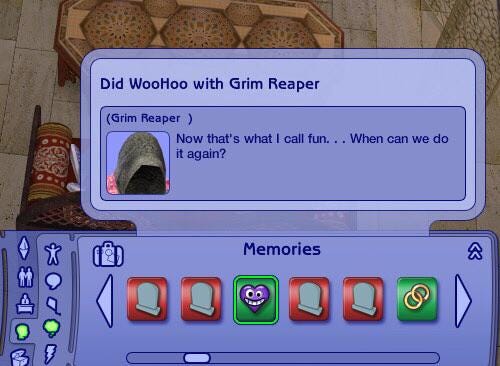
Olive is the mother of a young man by the name of Nervous Subject, the test subject being held hostage by the Beaker family in town. While this may not be possible because Nervous has no memories associated with his mother and Olive’s “WooHoo with the Grim Reaper” memory occurred after Olive entered the life stage of “Elder,” we can only theorize that Nervous is the offspring of Olive’s unholy union with the series’ literal psychopomp. (I say unholy but honestly? Good for her, what a queen.)
One popular fan-theory about Olive’s potential career as a serial killer is that by killing other Sims, she is guaranteeing that her old flame will show up (and maybe spend some time with her). So. That’s romantic, I guess.
Honorable Mentions
There are quite frankly so many eerie features of this franchise that I could go on about it forever. However, I also understand that not everyone is willing to read 100,000 words about Sims world narrative… so I’ll just link you to the Creepy Things In The Sims Iceberg.
Why Does The Spooky Stand Out?
Have you ever wondered why you are so much more likely to remember the biting or mean things that someone has said, rather than the kind compliments? Or why you might remember a traumatic experience with greater clarity than what you might consider the best day of your life?
Turns out? Our brains are wired to do this! What’s commonly referred to as “Negativity Bias” in psychology has wide-reaching implications for the noted “positive-negative asymmetry” of how our brains process stimuli.
And this isn’t just your brain being mean to you: this phenomenon is believed to have stuck around because it’s evolutionarily advantageous. That is, when you remember something bad that has happened in the past: whether it’s criticism from a loved one or a traumatic experience, you are more likely to avoid it or navigate it better in the future, thus allowing you a greater chance of survival. Remembering that which is scary or otherwise off-putting serves a very similar function.
“Fear is an evolutionary tool that warns us about potential danger. We’re primed to remember the things that scare us… because you want to be able to avoid them the next time. If you don’t remember fearful environments and fearful situations that are happening, you’re not going to survive.”
- Tulane University Neuroscientist Jeffrey Tasker, senior author of Gq neuromodulation of BLA parvalbumin interneurons induces burst firing and mediates fear-associated network and behavioral state transition in mice
The above linked study (with its very verbose and jargon-filled title) is actually a very important one: memory is something that impacts everyone’s life on a day-to-day basis, but scientists are still trying to identify the exact mechanism of how it works within the brain. This would be the case even at the best of times, but especially when it comes to formation of memories under stressful circumstances such as those that might cause an individual to develop Post Traumatic Stress Disorder (PTSD), even less is understood.
“We are particularly interested in the stress modulation of the memory process,” says Xin Fu, a neuroscientist at the Massachusetts Institute of Technology and the study’s lead author.
To learn about how brains react to fear, Fu, Tasker and their colleagues focused on norepinephrine, also called noradrenaline, a hormone released in stressful circumstances. They dosed mice with norepinephrine and then studied their brain activity. Researchers found that norepinephrine changed the pattern of electrical activity in the brain.
“Norepinephrine is a stress signal,” says Tasker. “It’s a modulatory signal that either increases or decreases circuit activation.”
In the case of norepinephrine, the researchers found that the neurotransmitter caused a bursting pattern of electrical impulses in the amygdala. Tasker says that they saw “clusters of these electrical discharges, and then separated by 30 seconds of silence, and then another cluster of electrical discharge,” a pattern that Fu describes as “very surprising.”
- Discover Magazine, “Why We’re Hard-Wired to Remember Things That Scare Us”
The brain is, for better or worse, a collection of electric switches and signals. Being able to replicate that stress modulators like cortisol and norepinephrine are able to intrinsically change the method by which those electrical signals fire is monumental to making concrete steps to understanding memory. These “bursts” could help facilitate the formation of new memories, with the extra jolt of electricity allowing the brain to catalogue more details about the specifics via neuron connections: all to help us with future threat evasion.
This is all to say: our brains are wired to jot down more details about that which scares us - and that’s evidently a feature, not a bug! Reading this study made me feel a lot less weird about how my brain always likes to pick out the strange, eerie details of whatever media or art I’ve been enjoying lately: and it especially makes me feel right at home when it comes to The Sims.
But if this data is any standard, it means that adding some eeriness or spookiness to whatever it is that you’re making could actually be an excellent option for allowing your game to stand out. Games are already known for literally capitalizing off of things like dopamine reward circuitry built into our brains, so putting something spooky into your next title isn’t any kind of “bio-hacking.” Even though that would be pretty cool.
As far as I’m concerned: including some spooky details to your game isn’t just an artistic choice - it’s a human one. The kind of choice that our ancestors evolved specifically to handle. The kind of choice that screams [yourName will remember that.]
Thanks for reading another installment of Resident Anna! As a kid who grew up in the early 2000s, The Sims series has such a special place in my heart. If you love learning about the greater world space and metanarrative of the Sims series, I really recommend checking out The Sims Lore channel on YouTube. She’s got all kinds of videos that span the entire series and even some let’s plays if you want some nostalgia.
I’m already really excited about February’s article, because it’s the first time I’ve officially interviewed someone for this publication! Who might it be, and about what? You’ll just have to subscribe and find out…
Catch ya on the flip side! Happy New Year!





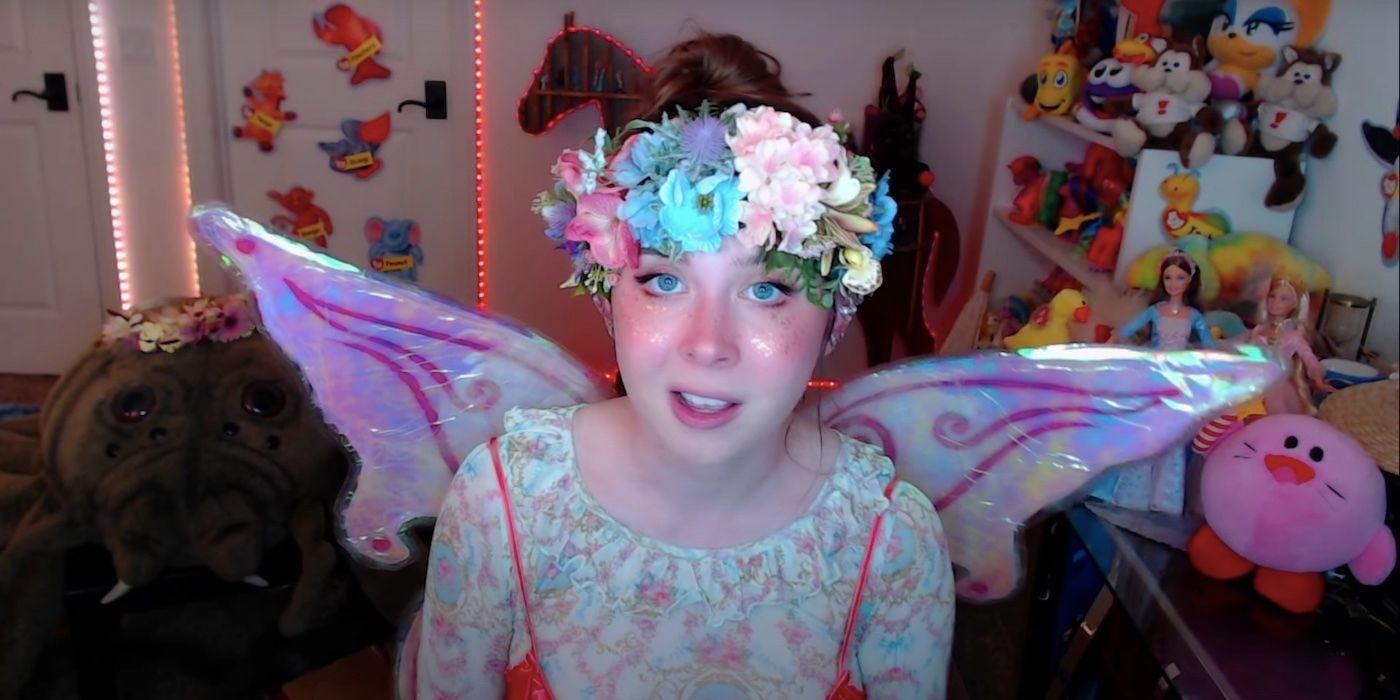

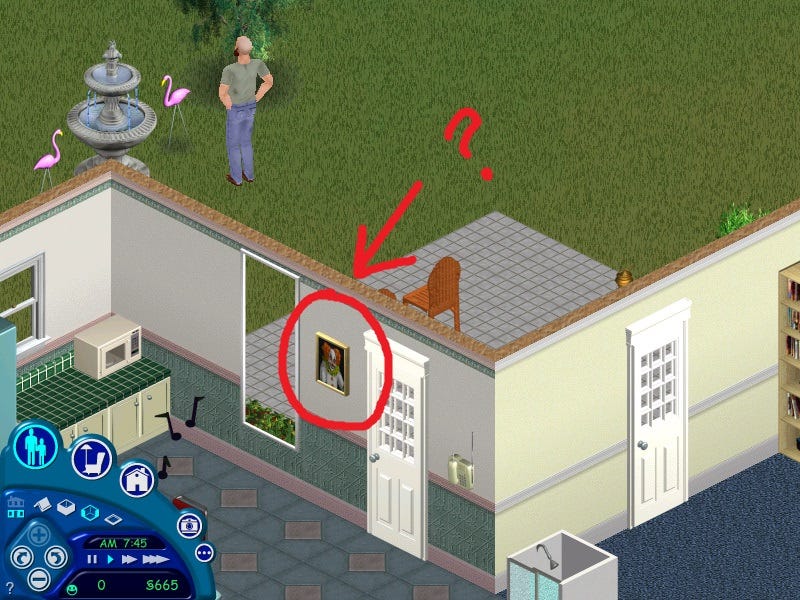

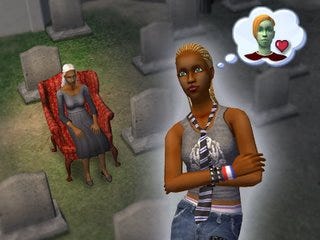
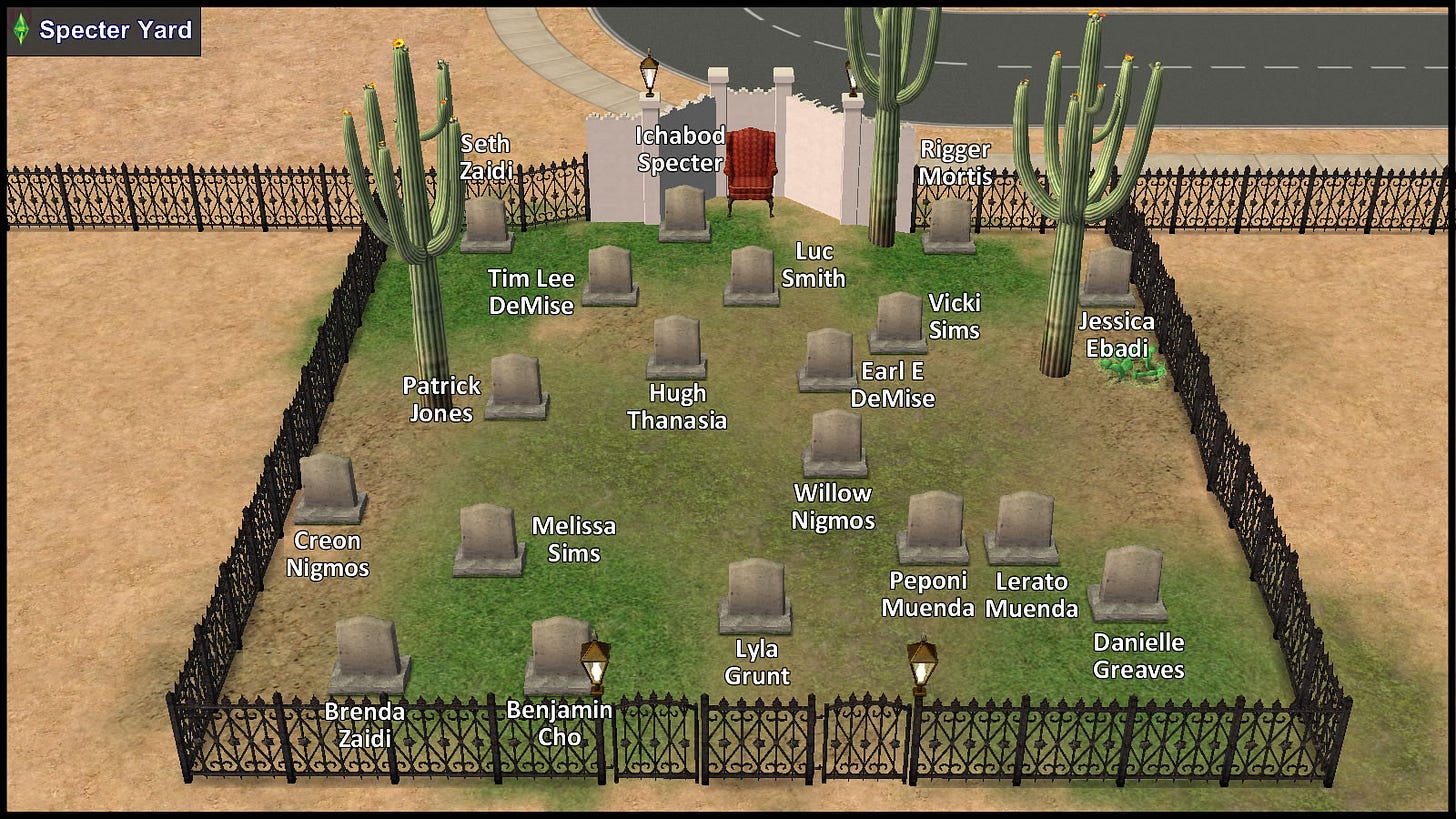

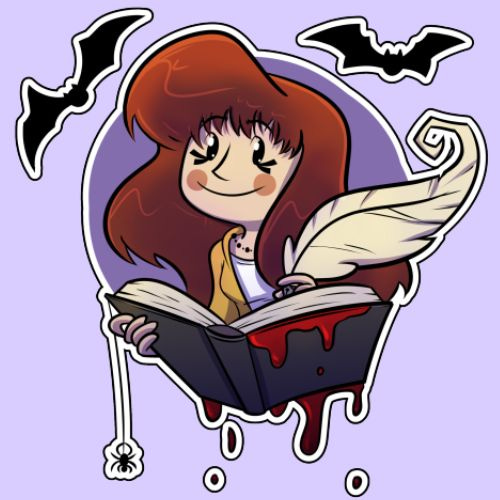
The essay that we deserved, bravo 👏 I've never been a fan of the Sims series (nor a hater tho), but I always liked a well-crafted material about it. Never heard of the clown or a serial killer who dated the Grim Reaper and so on 😅 thx a lot for putting much effort into it.
I'd like to emphasize how sleek the formatting of your essay is: it's not a wall of text, but a compilation of various techniques/tools such as text itself, headings, visuals, quote blocks, etc. Such an approach eases life of any reader, but especially one with ADHD like me 🥹✨
I LOVED the Sims as a kid and I'm honestly still gutted that when I played it when I was 20, after a multiple year hiatus, I just couldn't understand what was so fun about it. I played the Sims 2 for FULL WORKING DAYS on end as a kid but emulating adult life as an adult is just really not the same apparently.